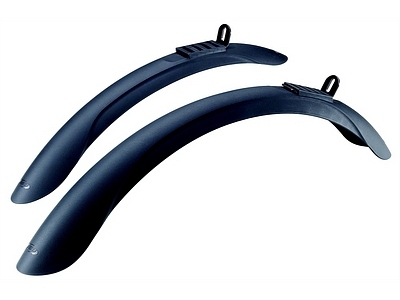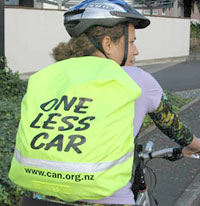Another dreary wet day and inevitably the number of people cycling takes a nosedive. Perhaps you are a “fairweather cyclist”. Perhaps you’d like to become more of an “all-weather” rider. So how to do that?

Disclaimer: I will mention some brands and businesses here, but they are just suggestions. And sadly I receive no commission from anyone!
As the old saying goes, “there’s no such thing as bad weather, just bad clothing.” In fact, when it comes to cycling in the rain, perhaps we should say “bad equipment”; as indicated below it’s more than just clothing. The key is to find gear that will keep you dry – or at least “dry enough”:
- It is a curious thing how most bikes sold in New Zealand don’t come with mudguards as standard. People just grab the nearest mountain bike or road bike sans guards and put up with biking into work with a wet bum and spray in their face. It’s pretty easy to retrofit mudguards to most standard bikes (just make a note of what holes you have in the frame for attaching them). Most of them are also easily removable should you have a hankering to hit the trails on the weekend. I replaced my last ones with a pair of BBB Rain Warriors that cost me less than $30 at Hub Cycles (fancier ones like Topeak might cost you a bit more). Or the next time you’re looking at a new bike purchase, make sure that you tell your retailer that you are only looking for models with mudguards – they might start to get the hint…

- Next you might want to think about how to keep your top half dry. A decent weather-proof jacket is one of the best investments you can make. It will probably set you back the best part of at least $200, but if you consider what money you’ll save not taking the car or bus on a rainy day, then that will probably pay for itself reasonably quickly. I got my last rain jacket from Kathmandu and it has lasted me well for about a decade (OK, maybe it’s starting to look worse for wear…). Another really good local player to look at for cycling jackets is Ground Effect. Of course, if you’re looking to go the stylish way and avoid any hint of fluoro, then any number of good jackets will do, for example local offerings Moa Gear. Another possible option with more flexibility when riding might be a rain poncho, which are usually inexpensive although you can also get fancier ones.
- If you’re concerned about the bottom half as well then you might want to look into some kind of over-trousers too that you can slip over your normal duds. In the past, I just grabbed some PVC trousers for ~$20 from The Warehouse; they also have polyester pants that will do for a light shower. Many of the same suppliers for jackets will also provide you with waterproof over-trou offerings, e.g. Ground Effect’s quite styly 3/4 Helter Skelters and my current full-length faves: Splashdowns; I keep them zipped up in the bottom of my pannier for whenever the occasion arises.
- On a wet day you might also want to keep your feet dry. Like tramping, a good pair of woollen socks and hiking boots might be just the trick on a wet day. Alternatively you can get booties that will cover your normal shoes, and if you really want to go low-rent, I’ve seen people just put plastic bags over their shoes. Or maybe you just make sure that you have a second pair of shoes for wearing at your destination.
- How to keep your other gear dry? One way is to get yourself a good-quality water-proof pannier bag. Alternatively, if you already have your favourite backpack or pannier, you could get yourself a waterproof backpack/bag cover – lots of models out there (nice and bright for visibility too). As a simple measure, packing your stuff in plastic bags inside your pack will also help immensely; I always have a bunch of plastic bags sitting inside my panniers and backpacks.

- If you already have your favourite jacket or shoes or bag and don’t really want to shell out for new waterproof gear, you could just try waterproofing your existing stuff. I’ve usually found something like Selleys Water Shield spray at K-Mart for ~$15; one can is usually enough to cover a few items. It’s not perfect and you’ll probably have to re-apply every year or two though.
Finally, it’s important to remember what’s the worst that could happen if you get caught in the rain – you get wet. You won’t melt! Because I usually shower at work instead of at home, I figure that it doesn’t matter if I get wet when riding – I’m going to get wet again anyway. And so long as I can take advantage of an oil column heater or a breezy/sunny window I can usually get any wet things dry for the trip home.
(NB: we also have some advice about cycling in the cold)
What is your secret to keeping dry when riding on a wet day?


Thanks, lots of good ideas. Any tips for people who wear glasses? Hardest thing I find is loss of vision due to raindrops on lenses.
Great article Lennyboy! Got me some mudguards, but still need to get overtrousers for those crazy Waikato days. Great suggestions and encouragement!
Jim Slim, how about a cheap pair of clear safety glasses over your prescription glasses?
Hey Jim, I find when there is a decent rain the water tends to run off my glasses (the rain tends to be in big droplets, the weight of them causes them to run off). I also try to do a good pace which I think helps as the wind helps blow off the droplets.
I could leave it there and say just bike faster :-). However fog is an example that is related, I find the droplets are small and don’t run off. The best solution I have found for this is to smear a thin layer of non-foaming handwash on the glasses. It can make it a little blurry, but it he droplets don’t settle so on balance it is much better. Just careful though, I’d avoid this if you have an anti-glare surface on a the glasses.
Perhaps opticians may have a better solution to apply to the glasses?
A bke cap with a visor helps a lot – if your helmet has a visor then its probably made with holes and isn’t that good at stopping water.
A bike cap will have a brim/peak/visor that is solid and will shed water. Downside though they spoil the airflow and its easy to fog up instantly when you stop at lights. The only solution is to pull up, and lower your glasses down your nose a little to get them away from the sweaty head. That is, make like you’re looking over the top of them. When you see the lights change to yellow the other way, push the glasses back up and ride away on the green.
Personally I do not recommend “baseball caps” because the corners come down too far and tend to mess up your quarter-vision. IE straight ahead is okay, but the 45 degree line can be obscured.
Divers trick is spit on them or lick them, then wash. Another is a drop of anti-fog liquid used for dive mask. Rain just flows off.
Timing is everything – the wonderful Bike Portland blog has just posted an article with tips on riding in the rain (and cold) – see http://bikeportland.org/2012/10/22/what-are-your-best-tips-for-staying-warm-and-dry-79158. There are even a few hints about cycling with glasses (search the comments); mainly around wearing visors and carrying a dry cloth.
…and a little closer to home, here’s some more useful advice on commuting in the rain – http://bikingtowork.org/7-ways-to-make-commuting-in-the-rain-pleasanter/
It’s not so much the getting wet part that makes me a fair weather commuter (although in winter when it’s cold too that’s definitely a factor), it’s the increase in the perceived hazard that puts me off. Brakes aren’t as effective (my next commuter will have disc rather than v brakes), and it feels like drivers are less likely to see you when it’s gloomy, drizzly, their windows are fogged up, etc. Also there’s all of those painted surfaces and metal drain covers to be extra wary of! Other than bright colours, lights, and being super defensive, any other suggestions?
Megan, V brakes properly adjusted with good pads just feel a little disconcerting when wet as they initially wipe the braking surface, the only times I’ve known them to be inadequate they were wet and muddy on steep off road.
Painted surfaces and metal drain covers shouldn’t be a problem with good tyres.
If you’re comfortable it’s little different than dry riding and there’s those nice feelings of being out in but safe from the elements and achievement that will have you declining lifts in foul weather once you’re accustomed to it.
I like a peaked cap for keeping my jacket hood and rain out of my eyes, waterproof or resistant gloves and gumboots (surprisingly unrestrictive).
Sorry to be unpatriotic but I have got my last 2 wet weather coats from England for less than $100. They are very bright and quite waterproof. The first one developed a faulty zip after 2 years almost constant wearing but I decided it was probably cheaper to get a replacement than replace the zip. NZ retailers just seem expensive, a further barrier to cycling.
One nice idea I picked up from a friend; if its wet but not freezing, wear cheap board shorts for cycling. They dry really fast, so you won’t have to put on wet clothes to go home.
Top idea. This was my standby for quite a long time; people would never quite believe that they’d dry in time but they always did.